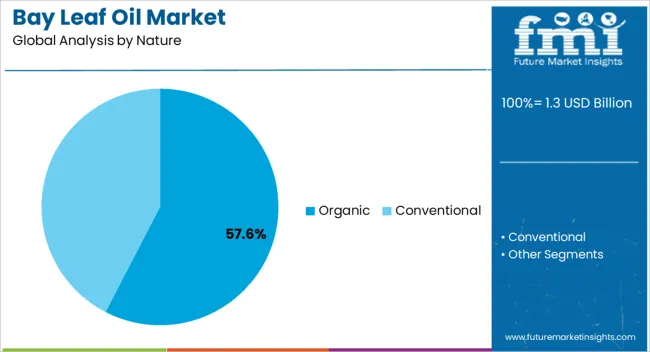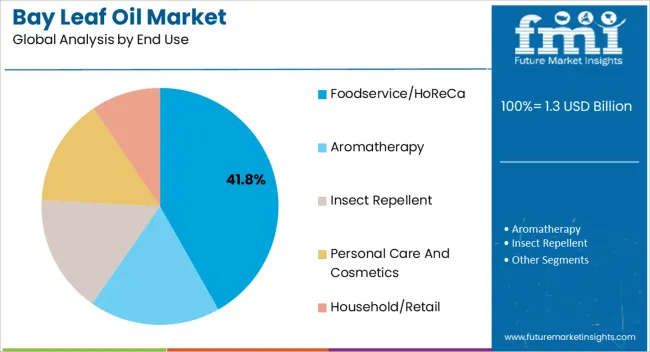The Bay Leaf Oil Market is estimated to be valued at USD 1.3 billion in 2025 and is projected to reach USD 2.7 billion by 2035, registering a compound annual growth rate (CAGR) of 7.1% over the forecast period.


| Metric | Value |
|---|---|
| Bay Leaf Oil Market Estimated Value in (2025 E) | USD 1.3 billion |
| Bay Leaf Oil Market Forecast Value in (2035 F) | USD 2.7 billion |
| Forecast CAGR (2025 to 2035) | 7.1% |
The Bay Leaf Oil market is experiencing robust expansion supported by rising demand across food, pharmaceutical, and personal care sectors. Current adoption trends highlight a clear shift toward naturally sourced essential oils due to increasing consumer preference for clean label products and sustainable sourcing practices. Growing awareness regarding the medicinal and therapeutic properties of bay leaf oil has reinforced its use in wellness applications, while its aromatic and flavoring characteristics are strengthening penetration in food and beverage industries.
Strong traction is also being observed in aromatherapy and natural cosmetics, where manufacturers are actively focusing on formulations that emphasize botanical authenticity. The ability of bay leaf oil to serve both functional and sensorial purposes has widened its scope across multiple industries.
Future growth is expected to be supported by continued innovation in extraction methods, the premiumization of natural ingredients, and rising adoption of essential oils in the hospitality and foodservice industries This trend positions bay leaf oil as a versatile product with sustained opportunities across global markets.
The bay leaf oil market is segmented by nature, process of extractions, end use, sales channel, and geographic regions. By nature, bay leaf oil market is divided into Organic and Conventional. In terms of process of extractions, bay leaf oil market is classified into Steam Distillation, Water Distillation, and Solvent Extraction. Based on end use, bay leaf oil market is segmented into Foodservice/HoReCa, Aromatherapy, Insect Repellent, Personal Care And Cosmetics, and Household/Retail. By sales channel, bay leaf oil market is segmented into B2C/Indirect, B2B/Direct, Supermarkets/Hypermarkets, Modern Grocery Stores, Specialty Stores, Traditional Grocery Stores, and Online Retailers. Regionally, the bay leaf oil industry is classified into North America, Latin America, Western Europe, Eastern Europe, Balkan & Baltic Countries, Russia & Belarus, Central Asia, East Asia, South Asia & Pacific, and the Middle East & Africa.

The Organic subsegment is projected to hold 57.60% of the Bay Leaf Oil market revenue share in 2025, making it the leading category by nature. This dominance is being attributed to the rising consumer inclination toward chemical free and environmentally sustainable products. Organic bay leaf oil is being favored in applications where product authenticity and natural purity are considered vital, particularly in food, cosmetics, and aromatherapy.
The segment has grown as consumers have become more conscious about the ecological impact of their purchasing decisions, with a preference for organic certifications ensuring trust and transparency. Regulatory frameworks promoting organic labeling and sustainable farming practices have further reinforced the segment’s credibility in the market.
Premium positioning of organic essential oils has also supported higher margins for producers while appealing to health conscious consumers seeking plant based alternatives As disposable incomes rise and wellness oriented lifestyles gain momentum, the organic segment is expected to remain at the forefront of market growth, supported by its quality assurance and sustainable production practices.

The Steam Distillation process is expected to account for 49.30% of the Bay Leaf Oil market revenue in 2025, positioning it as the most widely adopted extraction method. This process has maintained dominance due to its effectiveness in preserving the essential oil’s active compounds and aromatic properties without compromising quality. Steam distillation is considered reliable and cost effective, allowing for large scale production while maintaining the therapeutic benefits that are critical for applications in aromatherapy, pharmaceuticals, and cosmetics.
The method has been favored by manufacturers because it requires minimal chemical involvement, aligning with the clean label movement and consumer preference for naturally derived products. Its ability to produce consistent quality has ensured steady adoption in regulated markets where product safety and authenticity are paramount.
Moreover, technological improvements in distillation equipment have enhanced efficiency and yield, further strengthening its role as the preferred extraction method As demand for essential oils rises globally, steam distillation is expected to sustain leadership by balancing cost efficiency with product integrity.

The Foodservice and HoReCa subsegment is anticipated to hold 41.80% of the Bay Leaf Oil market revenue in 2025, establishing it as the leading end use category. Growth in this segment has been driven by the increasing use of bay leaf oil as a natural flavoring agent in restaurants, catering, and hospitality services. Its strong aromatic profile has made it a preferred choice for chefs and food operators aiming to deliver authentic taste experiences while also aligning with the clean label trend.
Demand has also been reinforced by the global expansion of culinary tourism and rising consumer interest in herbal infusions and gourmet cooking. Bay leaf oil has been increasingly integrated into sauces, marinades, and premium beverages, enhancing the dining experience.
The HoReCa industry has shown preference for natural and versatile ingredients that support differentiation in menu offerings, which has benefited this subsegment As dining trends continue to shift toward wellness inspired and natural food solutions, the foodservice and HoReCa segment is expected to drive sustained growth in the bay leaf oil market.
The bay leaf oil market is simmering with potential, driven by a confluence of factors. Traditionally used as a culinary herb for its distinctive aroma, bay leaves are now distilled into a potent essential oil with applications far exceeding the kitchen. Emerging markets for bay leaf oil products are being explored now.
The global market for natural products is flourishing, and bay leaf oil is finding fertile ground in new regions. Traditionally strong in Europe and North America, the market is witnessing a surge in demand from Asia Pacific, particularly China and India.
Developing regions are experiencing a rise in disposable income, coupled with a growing interest in natural ingredients for personal care and wellness. Additionally, the Middle East and Latin America are showing promising signs of increased demand for this oil's unique properties.
The wellness revolution is fueling the demand for natural products with potential health benefits. Bay leaf oil is perfectly positioned to capitalize on this health trend. Studies suggest its potential for promoting relaxation, reducing stress, and aiding in digestion. This aligns with the growing interest in aromatherapy and natural remedies. Manufacturers are incorporating this oil into products like diffusers, massage oils, and even natural sleep aids.
Consumers are increasingly seeking out organic and ethically sourced products. This clean label movement is driving the demand for organic bay leaf oil. Free from synthetic pesticides and fertilizers, organic bay leaf essential oil offers a premium option for those seeking pure and natural ingredients.
Organic certification ensures sustainable farming practices, appealing to environmentally conscious consumers. This growing demand for organic options presents a significant opportunity for producers who can cater to this segment of the market.
The bay leaf oil market is a dynamic and exciting space with the potential for substantial growth. As emerging markets embrace its versatility and health trends continue to favor natural ingredients, the future looks bright for this fragrant essential oil.

| Country | CAGR |
|---|---|
| China | 9.6% |
| India | 8.9% |
| Germany | 8.2% |
| France | 7.5% |
| Uk | 6.7% |
| USA | 6.0% |
| Brazil | 5.3% |
The Bay Leaf Oil Market is expected to register a CAGR of 7.1% during the forecast period, exhibiting varied country level momentum. China leads with the highest CAGR of 9.6%, followed by India at 8.9%. Developed markets such as Germany, France, and the UK continue to expand steadily, while the USA is likely to grow at consistent rates. Brazil posts the lowest CAGR at 5.3%, yet still underscores a broadly positive trajectory for the global Bay Leaf Oil Market. In 2024, Germany held a dominant revenue in the Western Europe market and is expected to grow with a CAGR of 8.2%. The USA Bay Leaf Oil Market is estimated to be valued at USD 459.9 million in 2025 and is anticipated to reach a valuation of USD 826.3 million by 2035. Sales are projected to rise at a CAGR of 6.0% over the forecast period between 2025 and 2035. While Japan and South Korea markets are estimated to be valued at USD 73.9 million and USD 46.9 million respectively in 2025.

| Item | Value |
|---|---|
| Quantitative Units | USD 1.3 Billion |
| Nature | Organic and Conventional |
| Process of Extractions | Steam Distillation, Water Distillation, and Solvent Extraction |
| End Use | Foodservice/HoReCa, Aromatherapy, Insect Repellent, Personal Care And Cosmetics, and Household/Retail |
| Sales Channel | B2C/Indirect, B2B/Direct, Supermarkets/Hypermarkets, Modern Grocery Stores, Specialty Stores, Traditional Grocery Stores, and Online Retailers |
| Regions Covered | North America, Europe, Asia-Pacific, Latin America, Middle East & Africa |
| Country Covered | United States, Canada, Germany, France, United Kingdom, China, Japan, India, Brazil, South Africa |
| Key Companies Profiled | BASF SE, DSM, Croda International, Marine Ingredients, Golden Omega, TASA, Orkla Health, Monsanto Company, and DowDupont |
The global bay leaf oil market is estimated to be valued at USD 1.3 billion in 2025.
The market size for the bay leaf oil market is projected to reach USD 2.7 billion by 2035.
The bay leaf oil market is expected to grow at a 7.1% CAGR between 2025 and 2035.
The key product types in bay leaf oil market are organic and conventional.
In terms of process of extractions, steam distillation segment to command 49.3% share in the bay leaf oil market in 2025.






Our Research Products

The "Full Research Suite" delivers actionable market intel, deep dives on markets or technologies, so clients act faster, cut risk, and unlock growth.

The Leaderboard benchmarks and ranks top vendors, classifying them as Established Leaders, Leading Challengers, or Disruptors & Challengers.

Locates where complements amplify value and substitutes erode it, forecasting net impact by horizon

We deliver granular, decision-grade intel: market sizing, 5-year forecasts, pricing, adoption, usage, revenue, and operational KPIs—plus competitor tracking, regulation, and value chains—across 60 countries broadly.

Spot the shifts before they hit your P&L. We track inflection points, adoption curves, pricing moves, and ecosystem plays to show where demand is heading, why it is changing, and what to do next across high-growth markets and disruptive tech

Real-time reads of user behavior. We track shifting priorities, perceptions of today’s and next-gen services, and provider experience, then pace how fast tech moves from trial to adoption, blending buyer, consumer, and channel inputs with social signals (#WhySwitch, #UX).

Partner with our analyst team to build a custom report designed around your business priorities. From analysing market trends to assessing competitors or crafting bespoke datasets, we tailor insights to your needs.
Supplier Intelligence
Discovery & Profiling
Capacity & Footprint
Performance & Risk
Compliance & Governance
Commercial Readiness
Who Supplies Whom
Scorecards & Shortlists
Playbooks & Docs
Category Intelligence
Definition & Scope
Demand & Use Cases
Cost Drivers
Market Structure
Supply Chain Map
Trade & Policy
Operating Norms
Deliverables
Buyer Intelligence
Account Basics
Spend & Scope
Procurement Model
Vendor Requirements
Terms & Policies
Entry Strategy
Pain Points & Triggers
Outputs
Pricing Analysis
Benchmarks
Trends
Should-Cost
Indexation
Landed Cost
Commercial Terms
Deliverables
Brand Analysis
Positioning & Value Prop
Share & Presence
Customer Evidence
Go-to-Market
Digital & Reputation
Compliance & Trust
KPIs & Gaps
Outputs
Full Research Suite comprises of:
Market outlook & trends analysis
Interviews & case studies
Strategic recommendations
Vendor profiles & capabilities analysis
5-year forecasts
8 regions and 60+ country-level data splits
Market segment data splits
12 months of continuous data updates
DELIVERED AS:
PDF EXCEL ONLINE
Bay Leaf Market Size and Share Forecast Outlook 2025 to 2035
Abies Alba (Fir) Leaf Oil Market – Growth & Demand 2025 to 2035
Leaf Spring Assembly Market Size and Share Forecast Outlook 2025 to 2035
Bays and Bows Window Market Size and Share Forecast Outlook 2025 to 2035
Oily Waste Can Market Size and Share Forecast Outlook 2025 to 2035
Oil and Gas Seal Market Size and Share Forecast Outlook 2025 to 2035
Oil Coalescing Filter Market Size and Share Forecast Outlook 2025 to 2035
Oil-immersed Iron Core Series Reactor Market Size and Share Forecast Outlook 2025 to 2035
Oil and Gas Sensor Market Forecast Outlook 2025 to 2035
Oil Packing Machine Market Forecast and Outlook 2025 to 2035
Oil and Gas Pipeline Coating Market Forecast and Outlook 2025 to 2035
Oilfield Scale Inhibitor Market Size and Share Forecast Outlook 2025 to 2035
Oil-in-Water Anionic Emulsifier Market Size and Share Forecast Outlook 2025 to 2035
Oil and Gas Field Services Market Size and Share Forecast Outlook 2025 to 2035
Oil Control Shampoo Market Size and Share Forecast Outlook 2025 to 2035
Oil Expellers Market Size and Share Forecast Outlook 2025 to 2035
Oilfield Stimulation Chemicals Market Size and Share Forecast Outlook 2025 to 2035
Oiler Kits Market Size and Share Forecast Outlook 2025 to 2035
Oil Pressure Sensor Market Size and Share Forecast Outlook 2025 to 2035
Oil Filled Power Transformer Market Size and Share Forecast Outlook 2025 to 2035

Thank you!
You will receive an email from our Business Development Manager. Please be sure to check your SPAM/JUNK folder too.
Chat With
MaRIA